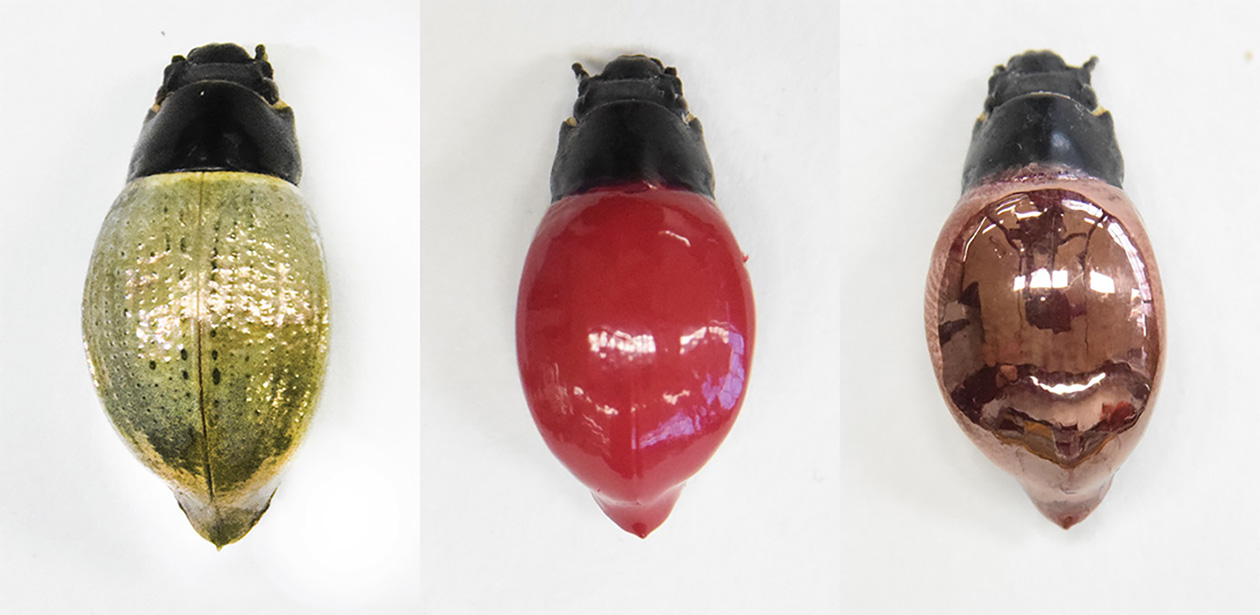Beetle morphology influences fog droplet collection, researchers find

Examples of Onymacris bicolor beetles under different treatments: Nanoscale-thin gold paint to change wettability (Left), nail polish to remove texture (Middle), and nail polish with gold on top to change both texture and wettability (Right). / Hunter King
In coastal arid regions where water sources are scarce, windborne fog droplets play a crucial role in sustaining life. Many plants collect droplets from the fog, serving as a vital water source for various organisms, but a few beetle species have evolved their own unique strategy for water collection - utilizing their bodies to intercept the droplets. However, the mechanics behind this process have long puzzled researchers due to the beetles' bulky morphology. In a recent study published in PNAS Nexus, scientists delved into how adaptations in the beetles' back enable them to gather enough water.
Two species of Namib desert beetles make use of a behavior called fog basketing to collect water droplets from the morning fog. They ascend dunes and balance on their front appendages, leaning their bodies into the wind. Microscopic droplets from the fog accumulate on the beetle’s back, and then trickle towards its mouth. Given that slender structures, akin to those observed in plants and human-made meshes used in arid regions, are best for fog droplet collection, questions arose regarding the feasibility of water collection with the beetles' morphology.
“In terms of fluid dynamics, water collection efficiency is way higher with thin structures like a mesh,” explained Hunter King, an assistant professor of physics at Rutgers University. “But if you’re a beetle, you’ve got a ball shaped body, and you don't have the freedom to change your geometry that wildly. We wanted to determine the strategy they use for a situation that's not ideal to begin with.”
The experiment comprised two main components: a computational phase and an experimental phase. The computation segment, led by Mattia Gazzola (M-CELS), an associate professor of mechanical science and engineering at the University of Illinois Urbana-Champaign, involved the creation of models to assess the impact of various surface geometric features on water collection. Utilizing data from these simulations, they then produced 3D printed models replicating different curvatures and surface properties derived from the models.
In the experimental phase, led by King, these 3D printed models, alongside deceased beetles, were employed to gauge their water collection capacity. The researchers constructed miniature tunnels to channel fog, where the models and beetles were individually placed at the tunnel's end connected to a sensitive load-bearing measure. This apparatus measured how much water accumulated on the target’s surface.
In addition to altering the 3D printed targets, the scientists manipulated the surface features and wettability (how hydrophobic or hydrophilic something is) of the beetles to investigate its effect on water accumulation. Given that the beetles' backs are inherently hydrophobic, the researchers coated beetles with a nanoscale-thin layer of gold to render them hydrophilic. To eliminate surface irregularities, an intriguing method was employed: applying nail polish to smooth out the beetle's backs. Some beetles received only gold or nail polish, while others were coated in both.
“We wanted to change the geometry of the beetles without changing the wettability, and the student working on this came up the elegant solution to use nail polish,” said King. “Just as nail polish makes a perfect layer, smoothing out all the details on a nail, it worked the same way for the beetles.”
They found that in both the 3D models and the beetles, surface bumps and a textured surface resulted in the most water accumulation. Similar to rain droplets colliding with the pavement, Gazzola explained that water particles that collide with a flat surface tend to be mostly deflected away. However, the introduction of bumps and slopes alters the trajectory of the colliding water, facilitating increased water retention.
“We show in our designs that if you add bumps on the back, resulting in these very sharp deflections in the back’s curvature, the water particles hit the bump, but then the flow continues to move along the back,” explained Gazzola. “And then it continues to flow over another bump and another, and the space between bumps then serve as traps to collect the water.”
Surprisingly, the researchers discovered that the wettability of the beetles did not substantially influence water collection; instead, only geometric features played a significant role. However, the researchers did observe that wettability influenced the directional movement of water down the beetle's back, supporting previous research underscoring the importance of wettability in guiding water towards the beetle’s mouth.
“Cumulatively from a very smooth surface, we found that adding microscopic geometric features plus a roughness on the surface gives you about a 400% increase in water collection,” said Gazzola. “Now this is still a very small amount of water, but the beetle is also very small, so it’s enough water for its needs.”
The team says these findings likely won’t be applicable for collecting water on the scale that humans need, but the results could inform material designs for when the opposite pattern is desired – avoiding water accumulation.
“We show that by changing the texture of something that wouldn't otherwise have caught very much moisture, now it’s collecting more,” said King. “This is great from the beetle’s perspective, but this same effect could be disastrous if you don't want to collect droplets on something. There are aerodynamic elements for wind turbines or planes that involve changing the surface morphology so that drag is reduced, but that same thing might cause icing to be a much bigger issue.”
This experiment offers a biological insight into how the beetles, despite their shape, manage to gather enough droplets by fog basketing. Moving forward, the team intends to delve further into the adaptations of organisms with diverse masses and shapes in managing water and heat exchange.
This study was funded by NSF, and can be found online at https://doi.org/10.1093/pnasnexus/pgae077

